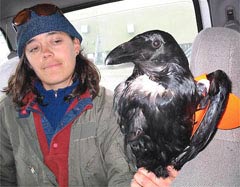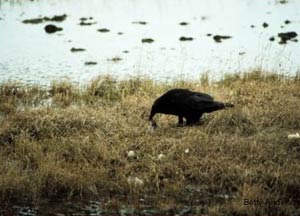 by Doug Schneider April 05, 2005
Ravens, those large, raucous, black birds seen perched atop streetlights or foraging in the back of pickup trucks, were never common on Alaska's treeless northern coast. But towers, buildings, and landfills in the state's sprawling Prudhoe Bay oil fields are giving ravens a reason to stay. Stacia Backensto is a Ph.D. student with the University of Alaska Fairbanks Regional Resilience and Adaptation Program. She says about 17 breeding pair of ravens have established nests atop communication towers, drilling platforms, pump stations, and other structures within the oil fields. Backensto said, "They are definitely situated for the most part on major facilities and drill-site pads. They tend to be on the buildings themselves, but there are some nests that are on communication towers that are next to the buildings or structures. Some of the nests are on fire escapes. Some of the nests are on top of exhaust vents. The really smart birds have nests on top of heated pipes, not too hot, but just warm enough to help a female incubate eggs during those really cold weeks of early April and May." Backensto is trying to learn just what impact oil development is having on Alaska's most familiar bird, and how the area's growing population of ravens may be affecting the region's other wildlife. She says the oil fields, as well as nearby Alaska Native villages and abandoned military sites, all provide ravens along the Arctic coastal plain with the things we all need to survive: food and shelter. Backensto said, "I think two things happened. We provided a consistent food source to them at a time when they are usually food-limited in the winter. Given that, they were able to start being resident birds in those areas. And secondly, the structures actually gave them an opportunity to nest. That was the primary limiting factor for a breeding population of ravens on the coastal plain."
During the winter, when natural food is scarce, ravens, sometimes more than 100 at a time, congregate at the Prudhoe Bay landfill. Backensto isn't sure where they all come from. But with the arrival of summer, Backensto says nearly all the ravens stop using the landfill and begin to prey on rodents, bird eggs, and sometimes even the newly hatched chicks of ground-nesting birds. Backensto said, "We see them focusing to some degree on small mammals, lemmings, tundra voles. So we find bones and we have actually observed them. What's really interesting, and I didn't expect to find this, is that ravens kind of walk along the tundra and poke their heads into the lemming tunnels and eventually they get one. I call it the random walk. It looks like they are walking randomly around the tundra and eventually they get something. It's also probably a really good strategy where there is a high density of nesting birds. They are bound to flush a bird off the nest by walking along, and they can take the eggs or the chicks. And we have seen both-birds flying with eggs and birds actually pick up chicks off the ground." It's that kind of impact on local wildlife that Backensto hopes to learn more about as her research on ravens in Alaska's North Slope oil fields heads into the second of a three-year study. Backensto said,"There's the whole idea that you have an inflated predator population in a particular area around development that would not likely be there without that development." This summer, Backensto will attach transmitters to a number of ravens to learn more about their travels along the Arctic coast. She hopes to learn, for example, where breeding ravens that show up at the landfill during winter, but which don't have nests in the oil fields, are coming from and where they go once summer arrives.
This story is courtesy of Arctic Science Journeys. Arctic Science Journeys is a radio service highlighting science, culture, and the environment of the circumpolar north. ASJ is produced by the Alaska Sea Grant College Program and the University of Alaska Fairbanks.
|
|||||

